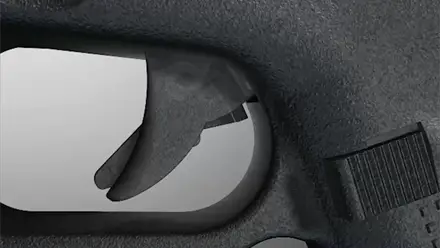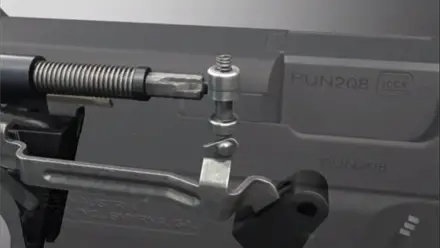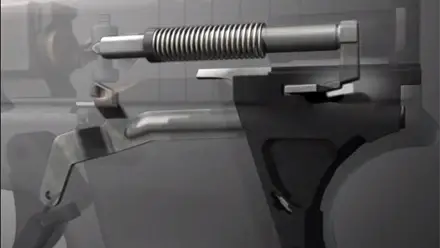I carry a Glock on my waist every day. I have now for 4 years. A friend told me they were known for going off when dropped, so I looked into it. Boy was he wrong.
A Glock has 3 internal safety features: Trigger safety, firing pin safety, and drop safety. The trigger safety requires a finger on the trigger to pull it. The firing pin safety blocks the firing pin until the trigger is pulled. The drop safety holds the firing pin in the rear until the trigger is pulled.
(illustrations by Glock)

Glock’s Safe Action System, a Drop Proof Design
Glocks are built using their 3-part Safe Action system. The Safe Action system consists of three fool-proof safety features that really go to show Glock’s ingenuity in gun manufacturing. They are the trigger safety, the firing pin safety, and the drop safety.

The trigger safety is a small, almost blade-like piece slightly sticking out from the center of the trigger. When the gun is racked back and the trigger is reset (ready to fire) the trigger safety engages and prevents it from being pulled. If you look at a Glock trigger, you can see it engage.
When engaged, a part of the trigger safety sticks out behind the trigger and rests against the lower frame of the pistol. this is effectively a lock that prevents the trigger from being pulled. The trigger safety is disengaged by pulling the blade on the front of the trigger.
It’s only depressed by pulling the trigger straight back, removing most of the chance the trigger could catch on clothing and go off without your consent. So, starting off, that’s a pretty good safety feature itself. But wait, there’s more!

Next up is the firing pin safety. The firing pin safety is itself a stout pin that blocks the firing pin from going forward enough to contact the primer of a cartridge in a chamber. The firing pin safety is disengaged by the trigger bar.
When the trigger bar goes back, it pushes the firing pin safety out of the way. that is the only possible time for a Glock to shoot. There is no way the firing pin will get past the firing pin safety without pulling the trigger, and that’s not going to happen without you knowing.
Both of these safeties are reset after the gun is fired, as the trigger is reset. Every time you pull the trigger, then ease back, two safety functions are automatically reset. It’s a pretty nice concept really. And Glock still did one better.

On top of that, there is the drop safety. The drop safety is yet another built-in feature for every Glock to ensure your safety. This safety mechanism is the rearmost part of the trigger bar and a drop-down arm of the firing pin. It’s a very good failsafe.
The drop safety engages a part of the firing pin at the rear, which locks it in place. As the trigger is pulled, the drop safety moves back, fully cocking the firing pin, then down to release it. that’s when the gun is allowed to fire. Before then, the firing pin isn’t even fully cocked.
In fact, if it were to somehow bypass the two physical barrier safeties, the firing pin still won’t have enough force to ignite a primer in a cartridge without the trigger being pulled. You would have to physically remove the firing pin safety and the drop safety for a Glock to fire without pulling the trigger.
Even then, it still wouldn’t fire because the drop safety is what fully cocks back the firing pin to strike a primer. I believe it truly is a fail-safe system that Glock puts into their pistols. And I’m not alone.
It’s people figure that with extreme use, a Glock will wear down the safety mechanisms and a Glock could go off on its own if the firing pin safety wouldn’t stop the firing pin and the drop safety was worn enough to slip off the firing pin. Still, the firing pin isn’t fully cocked, so it can’t.
Just to rest your nerves, Glock tested their pistol design with a test cycle of 100,000 live rounds without changing out any parts. There were no major or potentially dangerous malfunctions. The Safe Action system worked without fail.
Why do People say Glocks may Fire When Dropped?
Now this answer gets a little convoluted. If it’s not true, then why do people still spout it off as truth? Honestly, some people are just stubborn and think that something they hear once makes them an expert. But seriously, there’s always a bit of truth behind a myth this big right? Sort of, but not really.
It really seems to come from the fact that people were both poorly trained with Glocks, and that a lot of people have them. This whole idea really started as police departments were abandoning the previously used double-action revolvers for a modern, higher-capacity, semi-auto handgun.
We had a bunch of officers in the 80’s and early 90’s trading in their trusty revolver for a new-fangled Glock. Glocks have a much lighter trigger pull than a double-action revolver without the hammer cocked. Apparently, this is where the trouble came from.
According to studies done on early reposts of negligent discharge with a firearm in the police departments, there was a slightly higher number of Glocks going off from dropping than the old revolvers. Some of the reports decided the Glock may have an issue, but an in-depth look says otherwise.
The issue had to do with an officer dropping a loaded cocked pistol, then trying to catch it in the air, resulting in pulling the trigger by accident. Boom! Negligent discharge. With the revolvers’ harder trigger pull, this hadn’t been an issue before.
The fix resulted not in a change of gear, but in a stronger adherence to gun safety rules. Don’t touch the trigger unless you’re ready to shoot. The training element here has if your gun falls, let it thud before you pick it up.
When it’s flying through the air, you can’t tell where your fingers are going to go, but when it’s on the ground, you can safely pick it up. With any pistol, reaching for it, or trying to catch it while it is falling is much more dangerous than just letting it fall. Remember that in the future.
Other Myths About Glocks
There are more ideas about Glocks out there than there are facts to back them up. Since Glock came out with their Polymer lowers in the ’80s, a faction of the gun culture has sought to discredit them because they are different. There are myths and untruths galore in guns. Here’s some about Glocks.
“Glocks Have Dangerously Light Trigger Pulls”
What? Excuse me, but someone missed putting the light trigger pull on every Glock I’ve ever fired. Glocks are legitimately everywhere known for having long, somewhat firm trigger pulls. In fact, most people with Glocks eventually gripe about the trigger and consider swapping it out for a crisp, light, competition trigger.
“Glocks trigger Pulls are too Short to be Safe”
Literally, I’ve heard it! it’s completely ridiculous, but both of these myths stem from the great city of New York. In case you didn’t catch it, that last part was a joke. New York City is anything but great when it comes to guns.
Apparently, there were two instances in New York where a police officer with his gun out, “accidentally” shot the person he was pointing it at. Basically, the officer had a gun drawn, a person surprised the officer, and the officer involuntarily tensed his grip on the gun, shooting an innocent person.
The official decision from the department lawyer said it was an issue with the short and light trigger pull of the new Glock pistol.
Obviously, it was the guns fault, right? They thought so. They ordered a new batch of Glocks with a ten percent stiffer trigger spring because that will fix the issue, right? Yeah, sure it will. It didn’t make a difference, but it did start both of these myths.
If you own a Glock and are interested in learning how to upgrade the trigger for pennies at home, I wrote a full-length article on a DYI Glock trigger job. Here is the link.
Thank you, New York. You convinced a bunch of people that equipment is always the answer, never personal responsibility and training. Way to go!

